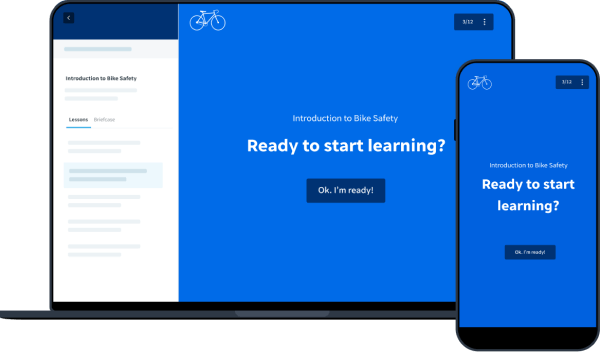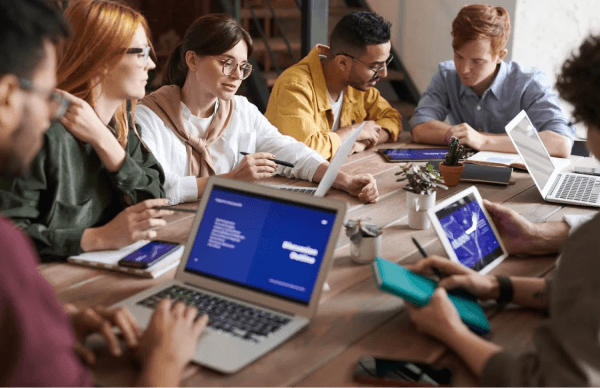10 Blended Learning Examples for Better Learning Experiences

Since the pandemic, blended learning has become a popular option for training and development worldwide. Besides making learning more fun and engaging, it also makes training easier to deliver to learners everywhere. Here’re some of the blended learning examples you can use to create better learning experiences.
1. Learning management systems
Learning management systems (LMS) are at the forefront of blended learning. Some platforms have been around since the early 2000s but only gained popularity around the 2010s. This blended learning example helps you manage courses and other learning materials on the system.

They typically have their own course and learning library available so you won’t have to worry about where to source them from. They also automate manual processes such as user enrollments, training adjustments, and performance reviews. You can use the data gathered from the platform to better develop your learner’s learning experience.
If you’re considering getting an LMS, then EdApp’s the best option for you. They have a ton of free features that are normally paid or part of premium plans on other platforms. These features include a massive course library, course authoring tools, third-party integrations, and a PowerPoint converter. You can also take advantage of marketing tutorials on their course library. EdApp also has document storage so your team can have easy access to important files such as HR policies, onboarding processes, etc.
Develop better learning experiences by signing up for EdApp today.
2. Learning experience platforms
Learning experience platforms (LXP) and LMS are often mistaken for each other or considered to be the same thing. But, they’re 2 very different types of blended learning examples. LMSs are mainly for learning content management while LXPs are for diversifying the learner experience. With LXPs, you’ll have more access to tools and features to customize your learner’s learning experience any way you want. LXPs do this by incorporating gamification, microlearning, mobile learning, and active learning in the platform experience.

Luckily for those looking for an LXP, EdApp has all of these features and more. Apart from being an LMS, EdApp also values delivering the best learner experience with the current learning and development (L&D) trends today. All of the courses are designed with gamification, microlearning, mobile learning, and active learning in mind. They also have features like Rapid Refresh and Brain Boost which use spaced repetition and reinforce learning.
3. Team building activities
Most people believe that learning is more enjoyable when done with others. Team building activities are blended learning examples that unite your workforce through teamwork and collaboration exercises.

When done correctly, it can become a way to break down communication barriers and encourage everyone to add something to the table, resulting in a collaborative culture of learning. The team’s collective experiences, ideas, and knowledge can bring fresh views and insights to your organizational processes and strategies. This can lead to improved work performance and more achieved goals.
Team building exercises frequently turn your team into a close-knit one, which is also a great thing to have. This is because employees will be more motivated to share their expertise with one another, instead of keeping it to themselves. This makes learning more organic, not static, in the workplace.
4. Mentoring
Mentoring is a must-have blended learning example for your L&D program. Apart from being a sought-after HR initiative, it also promotes organizational growth through sharing knowledge and experiences in mentoring sessions. The mentor passes on their expertise and tips to their mentee to better set them up for success. On the other hand, the mentee provides feedback and their own learnings to the mentor during their sessions.

Through this, mentors can put their knowledge to the test and sharpen their talents. They can also gain fresh perspectives and ideas from their mentees, which may help boost their job performance. By providing growth opportunities to each other, meaningful connections between members and leaders can develop into productive partnerships for your organization.
5. Peer-to-peer learning
Peer learning is a blended learning example where learners develop and deliver training information with their team members or in their training groups. This blended learning strategy encourages learner involvement and trust, which is especially important for remote learning.

Peer learning is easy to include in any training program. You can start by giving them a brief list of options to discuss with their teams or groups. Make each learner present their topic with the rest of the group. When you use this blended learning example, you can also consider facilitating these presentations during the learning session.
6. Mobile learning
While most blended learning takes place in-person and on PCs, having your microlearning courses, training videos, and podcasts mobile-friendly opens up a new world of possibilities. For starters, mobile learning enhances learner engagement and completion rates since they can easily access their learning content.

M-learning, supported by an event app provides maximum flexibility by letting learners attend training courses whenever and wherever they desire, even while on the go. What’s more? You can also take advantage of additional features in a mobile event app such as push notifications to notify learners of new courses or to remind them of upcoming deadlines.
7. Seminars
If you want to include in-person training, sending employees to seminars is a great blended learning example to consider. Your learners will be able to directly hear from field experts and have a more personal experience with training. These experts are widely-recognized leaders and think tanks who can offer your learners a spark of enthusiasm while extending their knowledge.

They can use these seminars to network and create more professional relationships for your organization. Digital business cards can be helpful in making more contacts with professionals by allowing for easy and instant sharing of contact information. This can develop their communication skills, which is an added benefit, on top of learning from industry experts.
8. Webinars
Webinars are blended learning examples where live learning and informational events are held online. It’s an online extension of the seminar-type learning approach where the term originates from. One-to-many lectures and other presentations are widely used as the format. A webinar may also involve screen-sharing and demos, as well as many main presenters.

While webinars are normally considered live events, you can also record them for refresher training or for new learners. Your learners will also be able to easily refer back to the video in case they missed anything during the webinar.
9. Self-paced learning
Self-paced learning, also known as asynchronous learning, is a blended learning example in which learners can acquire new knowledge at their own pace and fit tor their learning style. It’s an excellent alternative for learners who’re finding it hard to strike a balance between tasks and training.

Aside from its convenience, self-paced learning is also an effective technique to stamp new skills and information on your learners. Because they have control over how they’ll accomplish their learning objectives, they can dedicate more time focusing on things that they find difficult, rather than be pressured by outside factors. Similarly, they can effortlessly skip lessons that they’re already familiar with without dragging others along.
10. Podcasts
Podcasts are blended learning examples that’re great for your auditory learners. It’s become a popular alternative for learning when your learners are looking for a more creative way to gain new skills and insights. Podcasts, like videos, began as an entertainment medium where producers discussed ideas and insights, mostly centering on a particular theme. It later became more popular in the L&D space.

Podcasts are a terrific way to learn since they’re easily accessible and available around the clock. To make the most of their time, your learners can listen to a podcast on their favorite platform during their downtime or on the go.
EdApp is a mobile learning management system designed for today’s digital habits, delivering more engaging and effective micro-learning directly to learners anytime and anywhere. Whether you need free OSHA 10 hour certificate courses to cybersecurity refresher training, this is the best place to go.
11. Microlearning
Microlearning is a mobile-friendly and digital-forward learning method that involves delivering highly targeted yet digestible learning content to your teams. Microlearning courses are bite-sized lessons that are highly interactive to help learners retain knowledge and engage with information that would otherwise be difficult to learn traditionally. This method has been effective in blended learning environments because you can take microlearning courses on virtually any device.
These courses are also highly adaptable and are paced with your learner's time and schedule. A lot of learning management systems and blended learning examples make use of microlearning.
12. Social Learning
If you're looking for types of blended learning that are effective for teams of all sizes, social learning is a great go-to method. Social learning involves using the expertise of existing team members to provide knowledge and experience to different employees across your organization. This just means your teams will be learning from each other. It's common to ask your peers for help with work because you're sure that they'll know exactly what to do. Social learning is simply systematizing this.
Adapting social learning into blended learning methods can be done through forums and discussion features on your learning tools. Driving conversation around difficult topics online and offline is a great way to make the most of both worlds. Tools like EdApp have built-in social learning features to help you interact with team members for a highly social learning experience.
Sign up for this blended learning tool today.
Author
Stephanie Escuadro
Stephanie is an eLearning content writer for EdApp, a microlearning solution designed for today's digital habits. She creates content about cutting-edge learning technologies and resources to help companies deliver great training experiences. When not absorbed in writing, she spends her time taking care of her dog and binge-watching.
